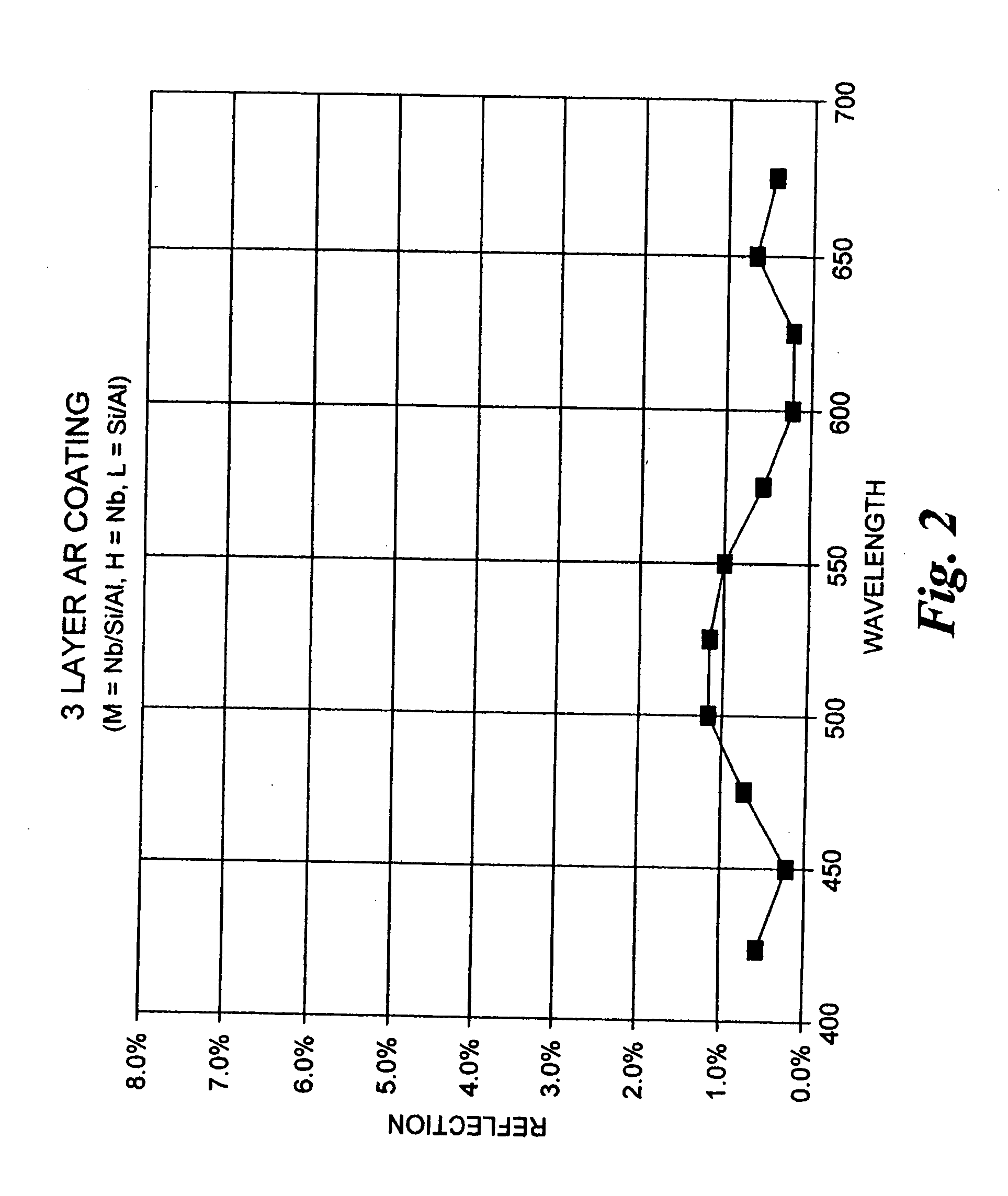Niobium oxide-based layers for thin film optical coatings and processes for producing the same
a technology of niobium oxide and thin film, applied in the direction of liquid/solution decomposition chemical coating, coating, instruments, etc., can solve the problems of increasing the overall cost of the coating system, fewer durable materials with such a specific index of refraction, and using expensive techniques such as vacuum evaporation or sputtering
- Summary
- Abstract
- Description
- Claims
- Application Information
AI Technical Summary
Benefits of technology
Problems solved by technology
Method used
Image
Examples
example 1
[0047] A mixture for preparing an H-layer was prepared by combining 61 grams of niobium pentachloride and 94 mL of 100% ethanol (anhydrous, denatured ethanol, SDA 2B-2), with stirring. After the niobium pentachloride had reacted with the ethanol, an additional 500 mL of ethanol and 25 mL of deionized water were added to the mixture. The mixture was then diluted to 1000 mL total volume with additional ethanol. This mixture was used in Example 4 to form a layer having an index of refraction of 2.03 on soda-lime float glass, and in Example 5 to form a layer having an index of refraction of 1.96 on polycarbonate.
example 2
[0048] A mixture for preparing an M-layer was prepared as follows: 66 mL of ethanol, 25 mL of tetramethoxysilane, 22 mL of deionized water, and 2.6 mL of glacial acetic acid were mixed at room temperature with constant stirring. During the stirring, the viscosity was measured every hour until a viscosity of approximately 3.0 to 3.2 centistokes was reached, roughly indicating the preferred extent of hydrolysis and condensation. At this point, 0.66 mL of 69% nitric acid were added to the mixture and the mixture was diluted to 1000 mL with additional ethanol. A separate solution was prepared by dissolving 74 grams of aluminum nitrate (Al(NO3)3●9H2O) in 1000 mL of ethanol. The second solution was then added to the previously prepared mixture. Finally, 500 mL of the resulting mixture were mixed with 500 mL of the H-layer mixture prepared in Example 1. This final mixture was used in Example 4 to form a layer having an index of refraction of 1.74.
example 3
[0049] A mixture for preparing an L layer was prepared by mixing 160 mL of ethanol, 93 mL of tetraethoxysilane, 54 mL of deionized water and 1 mL of hydrochloric acid (37%), while stirring at room temperature. During the stirring, the viscosity was measured every hour until a value of 3.0-3.2 centistokes was reached. A second solution was prepared by dissolving 2 grams of aluminum nitrate (Al(NO3)3●9H2O) and 50 mL of ethanol. This solution was mixed with the mixture containing the tetraethoxysilane. The combined mixture was diluted to a final volume of 1000 mL with additional ethanol. This mixture was used in Example 4 to form a layer having an index of refraction of 1.46.
PUM
| Property | Measurement | Unit |
|---|---|---|
| concentration | aaaaa | aaaaa |
| speed | aaaaa | aaaaa |
| temperature | aaaaa | aaaaa |
Abstract
Description
Claims
Application Information
 Login to View More
Login to View More - R&D
- Intellectual Property
- Life Sciences
- Materials
- Tech Scout
- Unparalleled Data Quality
- Higher Quality Content
- 60% Fewer Hallucinations
Browse by: Latest US Patents, China's latest patents, Technical Efficacy Thesaurus, Application Domain, Technology Topic, Popular Technical Reports.
© 2025 PatSnap. All rights reserved.Legal|Privacy policy|Modern Slavery Act Transparency Statement|Sitemap|About US| Contact US: help@patsnap.com



